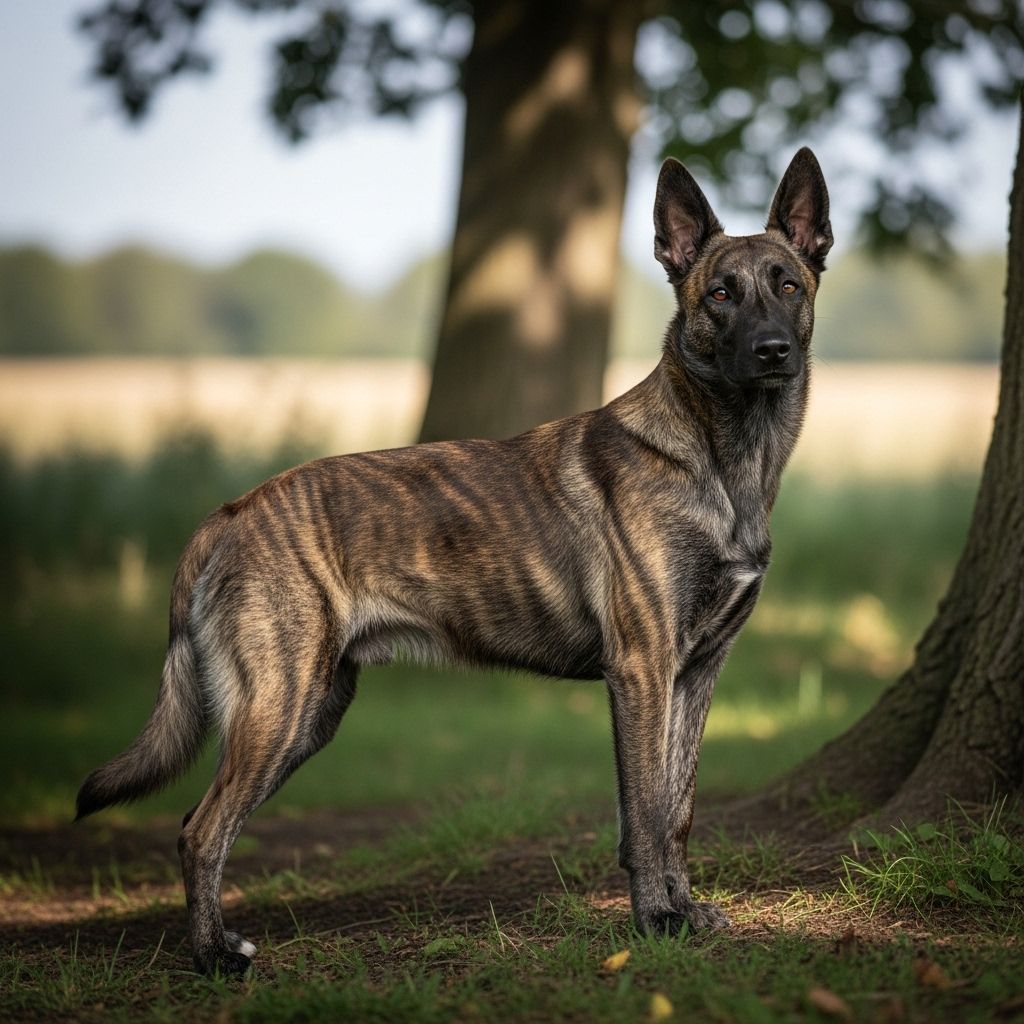Dutch Shepherd: Full Breed Profile, History, and Care Guide
A loyal, high-energy partner combining intelligence and strength for active owners.

Dutch Shepherd: Full Breed Profile, History, and Care
The Dutch Shepherd is a rare, highly versatile, and intelligent herding dog breed originating from the Netherlands. Renowned for its adaptability, loyalty, and work ethic, the Dutch Shepherd was developed to assist farmers and shepherds, excelling at a range of tasks from herding livestock to serving as a loyal family companion. This guide provides a detailed look at the breed’s history, personality, care needs, and more to help you determine whether the Dutch Shepherd is the ideal dog for your household.
Breed Overview
| Breed Group | Herding |
|---|---|
| Origin | Netherlands |
| Height | 21.5–24.5 inches (male), 20.5–23.5 inches (female) |
| Weight | 42–75 pounds |
| Coat | Short, long, or rough brindle coat |
| Color | Brindle (gold or silver tones) |
| Life Expectancy | 12–15 years |
| Temperament | Intelligent, alert, loyal, energetic |
History of the Dutch Shepherd
The Dutch Shepherd’s origins can be traced to the rural regions of the Netherlands in the early 19th century, where they emerged as naturally occurring shepherd’s dogs. Dutch farmers relied on these dogs for their remarkable adaptability, resilience, and skill at a variety of farm tasks. These included:
- Herding flocks of sheep and preventing them from wandering into crops
- Guarding livestock and property
- Pullling carts, especially milk carts
- Escorting livestock to markets and communal pastures
- Rounding up poultry and alerting families to visitors or intruders
The breed’s formal standard was created in 1898, initially allowing a variety of coat colors. To clearly distinguish the Dutch Shepherd from closely related breeds—such as the German Shepherd and Belgian Shepherd—the standard was revised in 1914 to restrict accepted color to brindle only. This move helped solidify the Dutch Shepherd’s unique identity, even as their numbers declined due to shifts from pastoral farming to industrialization.
Through the late 19th and early 20th centuries, shrinking sheep populations and changing agricultural practices threatened the breed’s existence. However, their intelligence and work ethic enabled the Dutch Shepherd to adapt, taking on new roles in police work, search and rescue, and even as guide dogs.
Characteristics and Personality
The Dutch Shepherd is best known for its high intelligence, eagerness to work, and loyalty. Their adaptable nature made them invaluable on Dutch farms, and today, they thrive in a variety of roles, including:
- Herding and livestock management
- Police and military assistance
- Search and rescue operations
- Service and therapy dog duties
- Loyal, active family companion
Key traits of the Dutch Shepherd include:
- Alertness: Quick to notice changes in their environment or the approach of strangers
- Loyalty: Strongly bonded to their family, often protective but rarely aggressive
- Adaptability: Able to transition between different tasks and environments with ease
- Playfulness: Enjoy family activities and vigorous playtime
- Independence: While trainable, they may show some stubbornness if not engaged appropriately
The breed usually gets along well with children and other pets when raised together or properly socialized. Their natural herding instinct can sometimes emerge in household settings, such as trying to “herd” children or other animals, but this is typically manageable with good training.
Appearance and Coat Types
The Dutch Shepherd is a medium-sized, athletic dog known for its balanced, unexaggerated structure. Traditional breed standards emphasize a well-proportioned body, expressive almond-shaped eyes, erect ears, and a long tail carried naturally. Muscle tone should be apparent but not overly bulky. One of the breed’s most distinctive features is its striking brindle coat.
Coat Varieties
- Short-haired: Dense, close-lying, harsh-textured fur
- Long-haired: Straight, flat, and dense; forms feathering on the legs and tail
- Rough (Wire)-haired: Tousled, harsh, and dense coat with a woolly undercoat; requires special grooming attention
All varieties feature brindle coloring—dark or gold stripes over a lighter background—which sets the Dutch Shepherd apart from cousin breeds. Small touches of white are allowed on the chest or toes but discouraged elsewhere.
Living Needs and Ideal Home
The Dutch Shepherd is best suited to homes with active families or individuals and ample space for exercise and stimulation. While highly adaptable, these dogs do not thrive in environments where they are left alone for long stretches or denied meaningful activity.
- Ideal for: Owners seeking an energetic, trainable, intelligent companion
- Space: Prefer homes with a yard; not ideal for apartment living without a commitment to intensive exercise
- Activity Level: High—requires daily vigorous activity, mental stimulation, and structured play
- Family: Good with children and other pets when properly socialized
Care and Grooming
Grooming needs for the Dutch Shepherd vary with the coat type:
- Short-haired: Requires weekly brushing to remove loose hair; increase frequency during shedding seasons
- Long-haired: Brush at least twice a week to prevent matting, especially on feathered areas
- Rough-haired: Needs regular brushing and periodic hand stripping to maintain coat quality
Basic care routines should include:
- Regular nail trims to prevent overgrowth
- Ear checks and cleaning to reduce risk of infection
- Dental hygiene, such as frequent brushing or dental chews
- Bathing as needed, depending on level of outdoor activity
Due to their coat and activity level, Dutch Shepherds are not prone to strong odors if groomed appropriately.
Exercise Requirements
The Dutch Shepherd is a high-energy breed requiring regular, vigorous exercise to remain healthy and happy. Insufficient physical or mental activity can lead to boredom and the development of unwanted behaviors. Recommended activities include:
- Long daily walks or jogs
- Time in a secure, open area for free running
- Agility, obedience, or herding classes
- Interactive games, such as fetch or puzzle toys
- Working roles, such as dog sports or specialized training
Enthusiastic and versatile, these dogs excel at nearly any canine sport or job, making them enjoyable companions for active owners.
Training and Socialization
Highly intelligent and eager to learn, the Dutch Shepherd responds well to positive, structured training. Early socialization and consistent training are essential to channel their energetic minds productively.
- Use positive reinforcement: reward-based training helps build trust and keeps lessons engaging
- Set clear boundaries: establish rules and routines from the start
- Stimulate with new experiences: introduce the dog to different sights, sounds, people, and pets
- Offer advanced training: consider obedience, agility, herding, or scent work
Confidence, gentle leadership, and patience are key. Dutch Shepherds are quick learners but may become bored with repetitive or overly easy tasks—keep training sessions varied and interesting.
Common Health Concerns
The Dutch Shepherd is generally a healthy and robust breed, but like all dogs, they have some potential health issues to watch for.
- Hip dysplasia: Less prevalent than in similar breeds but should be monitored
- Elbow dysplasia: Occurs less frequently but still a concern in some lines
- Eye problems: Includes conditions such as progressive retinal atrophy (PRA)
- Allergies or skin issues: Occasionally reported, especially with poor coat maintenance
Responsible breeders screen breeding dogs for these conditions to promote breed health. Regular veterinary care, balanced nutrition, and appropriate exercise can help maintain a Dutch Shepherd’s well-being throughout their 12–15 year average lifespan.
Diet and Nutrition
A high-quality, balanced diet helps maintain the Dutch Shepherd’s health, energy, and coat. Recommendations include:
- Feed age-appropriate commercial kibble or a carefully formulated home-cooked/raw diet under veterinary guidance
- Monitor food portions to prevent obesity in this active breed
- Ensure access to fresh water at all times
- Include joint-support supplements if recommended by your vet
Diet requirements may adjust based on the dog’s age, size, activity level, and specific health needs.
Where to Adopt or Buy a Dutch Shepherd
The Dutch Shepherd remains a relatively rare breed outside the Netherlands, so prospective owners should expect a waiting period and conduct careful research:
- Seek reputable breeders who perform health testing and prioritize the breed standard
- Explore breed-specific rescues and shelters in your region
- Visit breed clubs for referrals and information on responsible sources
Adopting or purchasing from a responsible source ensures the best possible health and temperament for your Dutch Shepherd and helps preserve this remarkable breed.
Frequently Asked Questions (FAQs)
Are Dutch Shepherds good with children and other pets?
Yes, Dutch Shepherds are generally excellent with children and can coexist peacefully with other animals when properly socialized from an early age. Their gentle nature and protective instinct make them loving family dogs, though their herding drive may prompt them to try to “herd” younger children or pets.
Do Dutch Shepherds need a lot of exercise?
Absolutely. Dutch Shepherds require significant physical and mental exercise daily. Without sufficient activity or stimulation, they may become bored or develop behavioral issues. Activities like agility, herding, or advanced obedience are ideal outlets for their energy.
Are Dutch Shepherds easy to train?
Yes. They are renowned for their intelligence, quick learning, and eagerness to please. However, they do best with experienced owners who can channel their energy positively and provide ongoing mental challenges.
How do Dutch Shepherds compare to German and Belgian Shepherds?
All three breeds share a close ancestry and working background. The Dutch Shepherd is generally smaller, comes only in brindle, and is often considered less prone to some genetic health problems than the other two. All require experienced handlers, meaningful work, and healthy socialization.
Can Dutch Shepherds live in apartments?
They can adapt to apartment living only if their exercise requirements are thoroughly met. However, they typically thrive best in environments with ample space and opportunities for off-leash activity.
Is the Dutch Shepherd Right for You?
The Dutch Shepherd is a perfect choice for active individuals or families seeking a loyal, intelligent companion who excels at work and play. Their versatile nature and eager disposition shine in homes where their exercise, training, and companionship needs are fully met. Before bringing a Dutch Shepherd into your life, ensure that you have the time, resources, and energy to provide for this remarkable dog’s physical and mental well-being.
References
Read full bio of Srija Burman












